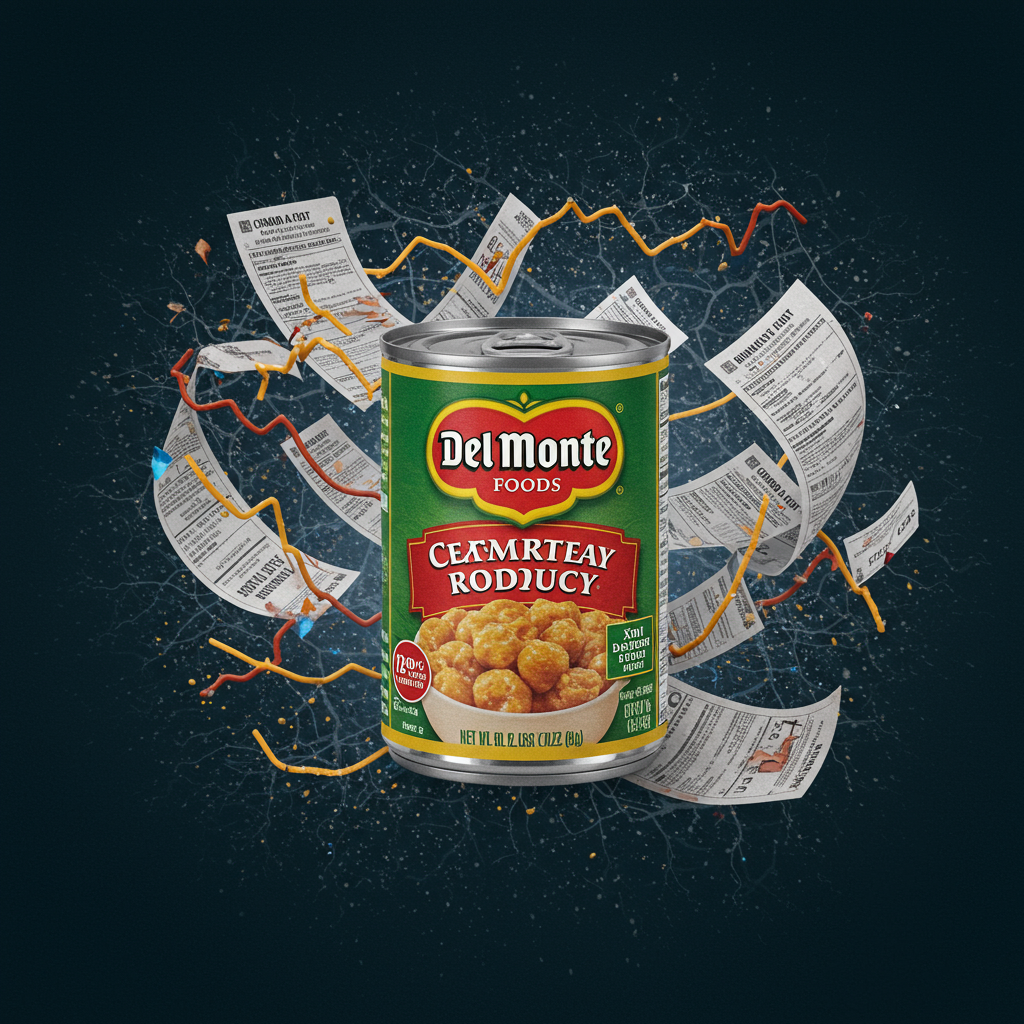Del monte Foods, a household name for generations and a fixture in grocery aisles worldwide, has officially filed for Chapter 11 bankruptcy. This significant step for the nearly 140-year-old company highlights mounting financial pressures driven by evolving consumer habits, rising operational costs, and substantial debt obligations. The filing initiates a court-supervised process aimed at restructuring and finding a buyer for the iconic brand.
The voluntary bankruptcy petition was filed in the U.S. Bankruptcy Court for the District of New Jersey on Tuesday. Company leadership, including President and CEO Greg Longstreet, stated this action was the result of a thorough evaluation of options. They determined that a court-supervised sale of most or all of Del Monte’s assets represents the most effective path forward. The goal is to accelerate a turnaround and build a stronger, more enduring company under new ownership with an improved financial structure.
Why Del Monte Foods Faced Financial Distress
The decision to seek bankruptcy protection comes after a challenging period for the California-based company. Several intertwined factors contributed to the financial strain that ultimately led to the Chapter 11 filing.
Navigating a Shifting Consumer Landscape
A primary driver of Del Monte’s difficulties is a notable shift in consumer preferences and spending habits. For decades, canned fruits and vegetables were kitchen staples, valued for their convenience and long shelf life. However, modern consumers are increasingly prioritizing fresh, frozen, and minimally processed foods. There’s a growing perception that these alternatives are healthier than traditional preservative-laden canned goods. This trend has directly impacted demand for Del Monte’s core product lines. Furthermore, economic pressures have led many shoppers to reduce spending or switch to less expensive private label brands, further eroding Del Monte’s market share and revenue.
The Weight of Debt and Operational Costs
Beyond changing tastes, Del Monte has been burdened by a significant debt load. Reports indicate that the company’s acquisition by DMPL was heavily debt-funded. Consequently, rising interest payments have become a major drain on resources, reportedly exceeding the company’s earnings before interest, taxes, depreciation, and amortization (EBITDA). Managing this substantial debt became increasingly difficult. Compounding these financial woes are increased operational costs. A decline in consumer demand resulted in a surplus of inventory. Storing this excess product in warehouses incurred significant expenses. The company also had to increase spending on promotions and discounts to try and move the accumulated stock.
Broader Trends Impacting the Canned Food Sector
Del Monte’s challenges are not entirely unique within the consumer packaged goods (CPG) industry. Several large food companies have recently announced job cuts, plant closures, and restructuring efforts as they grapple with cautious consumer spending and evolving market dynamics. Del Monte also faced specific industry headwinds, such as tariffs imposed on steel and aluminum. These tariffs increased the cost of its primary packaging materials, adding further pressure to profit margins. The seasonal nature of sourcing fruits and vegetables also presents inherent challenges, potentially leading to higher warehousing costs during peak production times.
The Chapter 11 Process: What Happens Next?
Filing for Chapter 11 bankruptcy does not mean Del Monte Foods is closing down immediately. It is a legal process that allows a company to restructure its finances and operations while remaining open.
Seeking a Buyer Through Court Supervision
The core strategy for Del Monte under Chapter 11 is to facilitate a court-supervised sale. This process is designed to attract potential buyers and secure the “highest or best offer” for the company’s assets. By undergoing the sale through the bankruptcy court, Del Monte aims to address its debt issues and transfer ownership with a potentially cleaner balance sheet. The company has already reached a restructuring support agreement with a group of its lenders, laying the groundwork for this sale process.
Securing Funding to Continue Operations
To ensure business continuity during the bankruptcy proceedings and the search for a buyer, Del Monte has secured a commitment for $912.5 million in financing from some of its existing lenders. This substantial funding, combined with cash generated from ongoing operations, is intended to provide sufficient liquidity. The company expects to continue operating as usual, delivering products to grocery stores and maintaining its supply chain throughout this period.
Company Profile: More Than Just Canned Peas
While widely recognized for its canned fruits and vegetables under the Del Monte brand, the company’s portfolio is more diverse. Headquartered in Walnut Creek, California, Del Monte Foods also owns and markets brands like College Inn (broths and stocks), Joyba Bubble Tea, and Contadina (tomato products). These other brands are also part of the assets being considered in the potential sale. The company’s rich history dates back nearly 140 years, establishing it as a long-standing player in the American food industry.
Previous Efforts to Stabilize the Business
The bankruptcy filing follows a period of intense operational adjustments and attempts to cut costs. In the years leading up to the filing, Del Monte reportedly undertook efforts to overhaul its debt structure. The company also implemented downsizing measures, including layoffs and the closure of plants and warehouses. For instance, a fruit processing plant in Washington state was recently shut down as part of these cost-saving initiatives. Despite these efforts, the combination of market pressures and debt proved too challenging to overcome without a more significant restructuring.
Implications for Consumers and the Industry
For most consumers, Del Monte has stated that the bankruptcy filing should not immediately impact their ability to purchase products. The company plans to continue its operations and product delivery throughout the sale process. However, the situation highlights the significant shifts occurring within the food industry. It underscores the challenges faced by traditional brands relying on categories like canned goods as consumer preferences evolve towards fresh, convenient, and perceived healthier options. The struggles of a major player like Del Monte also reflect broader economic trends affecting the entire CPG sector.
Frequently Asked Questions
Why did Del Monte Foods file for bankruptcy?
Del Monte Foods filed for Chapter 11 bankruptcy due to a combination of factors. These include significant debt from past acquisitions, increased operational costs related to surplus inventory and promotions caused by decreased demand, and broader shifts in consumer spending habits. Consumers are moving away from traditional canned goods towards fresher, healthier, or less expensive private label alternatives, impacting Del Monte’s sales and revenue.
Where was the bankruptcy filed, and what does Chapter 11 mean for the company?
The voluntary Chapter 11 bankruptcy petition was filed with the U.S. Bankruptcy Court for the District of New Jersey. Chapter 11 allows Del Monte Foods to continue operating its business while undergoing a court-supervised restructuring process. The company’s primary goal during this time is to facilitate a sale of its assets to a new owner, which leadership believes is the most effective way to address its debt and ensure long-term viability.
What does Del Monte’s bankruptcy mean for consumers and product availability?
Del Monte Foods has stated that it does not anticipate the bankruptcy process will affect its ability to deliver products to stores. The company has secured significant financing ($912.5 million) to ensure it has enough cash to continue operations throughout the Chapter 11 proceedings and the sale process. Consumers should expect Del Monte branded products, as well as others like College Inn and Joyba, to remain available on grocery store shelves.
Conclusion
Del Monte Foods’ Chapter 11 bankruptcy filing marks a pivotal moment for the nearly 140-year-old company. It underscores the intense pressures facing legacy food brands in a dynamic market shaped by changing consumer behavior and economic challenges. By entering bankruptcy, Del Monte aims to leverage a court-supervised sale process to shed debt, attract new ownership, and hopefully secure a more stable future. While the path ahead involves significant restructuring, the company intends to keep its operations running and continue supplying products to consumers throughout this critical transition period. The outcome of the sale will determine the next chapter for this historic American food producer.



